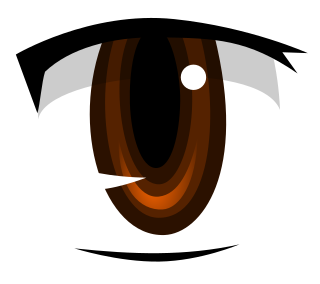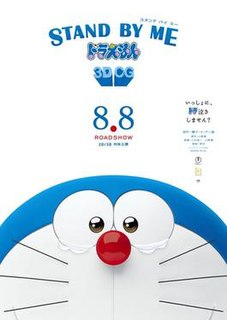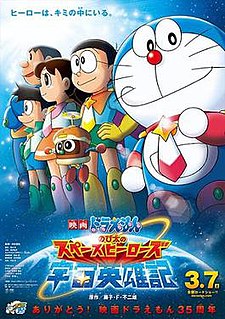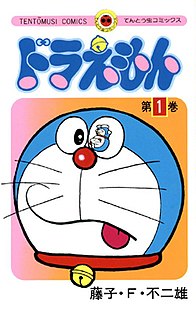
Fujiko Fujio was a pen name of a manga writing duo formed by two Japanese manga artists. Their real names are Hiroshi Fujimoto and Motoo Abiko. They formed their partnership in 1951, and used the Fujiko Fujio name from 1954 until dissolution of the partnership in 1987.

Little Ghost Q-Taro, by Fujiko Fujio, is a Japanese manga about an obake, Q-Taro who lives with the Ōhara family. Q-Taro, also known as Q-chan or Oba-Q, is a mischief-maker who likes to fly around scaring people and stealing food, though he is deathly afraid of dogs.

Doraemon: Nobita and the Birth of Japan is a feature-length Doraemon film which premiered in Japan on 11 March 1989. This was the first Heisei-era Doraemon movie. It's the 10th Doraemon film. In 2016, the movie was remade as Doraemon: Nobita and the Birth of Japan 2016.

Doraemon Wii - Secret Tool King Tournament known in Japan as Doraemon Wii - Himitsu Douguou Ketteisen is a video game based on the manga and anime series Doraemon. It was released in Japan on December 6, 2007 for the Nintendo Wii game console.

Doraemon is the most recent anime TV series based on Fujiko Fujio's manga of the same name. Produced by Shin-Ei Animation and Asatsu-DK, it began airing on TV Asahi on April 15, 2005.

Doraemon is the first anime TV series based on Fujiko Fujio's manga of the same name. It was produced by Nippon TV Video. It aired from April 1 1973 to September 30, 1973. After the anime ended, Doraemon remained exclusively a manga until 1979 when Shin-Ei Animation produced a more successful second anime adaptation, which officially ended in 2005; it was in turn replaced by a third anime adaptation shortly after which continues to air to recent days.

2112: The Birth of Doraemon is a short film about the life of Doraemon from birth, before coming to Nobita. The short film is sort of a prequel to the entire series, it showed the life of Doraemon before traveling to the 20th century: How he was made, how he was partially broken, how he lost his ears, how he met the Nobi family and decides to return to the past to help Nobita. It premiered on March 4, 1995 in Japan, sharing the same bill with Doraemon: Nobita's Genesis Diary. The original movie was made in order to understand the initial setup of the Doraemon Manga.

Chimpui is a Japanese manga created by Fujiko F. Fujio in 1985. It tells the story of two cute aliens that come to Earth to find the girl who will marry their prince of planet Mahl. It was subsequently adapted into an anime television series.

Stand by Me Doraemon is a 2014 Japanese 3D computer animated science fiction comedy film based on the Doraemon manga series and directed by Ryūichi Yagi and Takashi Yamazaki. It was released on 8 August 2014. It is the highest-grossing film of the Doraemon franchise. Bang Zoom! Entertainment premiered an English-dubbed version of the film at the Tokyo International Film Festival on 24 October 2014.

Doraemon: Nobita's Space Heroes, also known as Doraemon The Super Star 2015 and Doraemon The Space Hero, is a Japanese anime superhero film and the 35th Doraemon film. It was released in Japan on 7 March 2015. This movie commemorates the 35th anniversary of the Doraemon (1979) anime series and 10th anniversary of the Doraemon (2005) anime. This movie is similar to Doraemon's 6th movie, Nobita's Little Star Wars (1985).

Doraemon is a fictional character in the Japanese manga and anime series of the same name created by Fujiko Fujio, the pen name of writing team Hiroshi Fujimoto and Motoo Abiko. He is a male robotic cat that travels back in time from the 22nd century to aid a preteen boy named Nobita. An "official" birth certificate for the character gives him a birth date of 3 September 2112. and lists his city of residency as Kawasaki, Kanagawa, the city where the manga was created. In 2008, Japan's Foreign Ministry appointed Doraemon the country's "anime ambassador". His nickname is MS-903, Dora.

Ultra B is a manga series by Fujiko A. Fujio that first made its debut in Chuokoron-Shinsha's Fujiko Fujio Land series of tankōbon books in 1984 and was released in individual tankōbon until 1989. In 1987, the manga was adapted into a 120-episode anime of the same name by Shin-Ei Animation which aired on TV Asahi from 4 April 1987 to 27 March 1989. It is inspired by Doraemon.

Jungle Kurobe is a children's anime series by Fujiko Fujio.
Doraemon is an anime and manga which was composed by Fujiko F. Fujio in 1969 in Japan. The Doraemon franchise came to India in 2005 when the anime aired for the first time. The manga is yet to be released. It has won the Nickelodeon Kids' Choice Awards India two times in a row for Best Show For Kids and was nominated in 2016 and 2017 edition for the same category. It is the highest rated kids' show with about 478.5 million viewers. It is currently aired on Disney Channel.



















